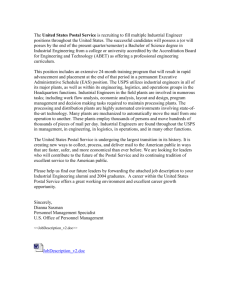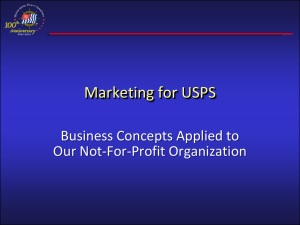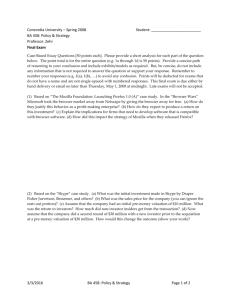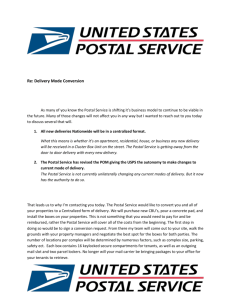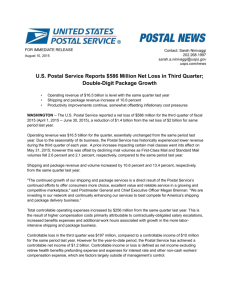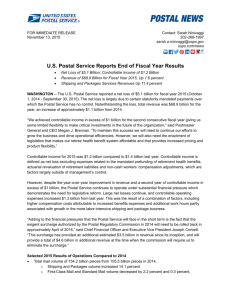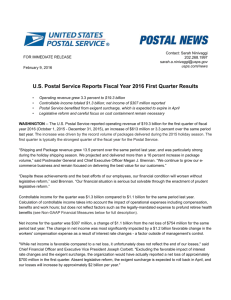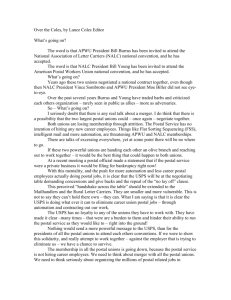Measuring the Social Value of Postal Services: Progress Report and
advertisement
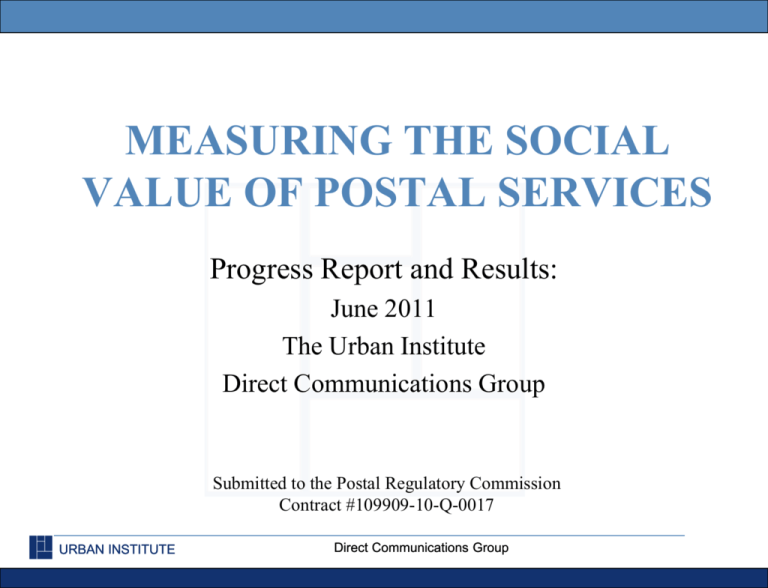
MEASURING THE SOCIAL VALUE OF POSTAL SERVICES Progress Report and Results: June 2011 The Urban Institute Direct Communications Group Submitted to the Postal Regulatory Commission Contract #109909-10-Q-0017 URBAN INSTITUTE Direct Communications Group OUTLINE OF PRESENTATION • • • • • • Introduction The three studies and their project teams Crime and Safety Study Economic Effects Study Transportation and Price Leadership Study Summary URBAN INSTITUTE Direct Communications Group 2 INTRODUCTION • Builds on an earlier Urban Institute study for PRC – completed in February 2010 – identified the array of benefits provided by the USPS— through its mail service and post offices—that contribute to the social value of the post • Current contract includes three substudies that consider areas of potential benefits—crime and safety, community economic effects, and pricing • Findings are limited, but contribute to planning for a future postal service that adapts to a changing communications environment and meets the needs of consumers URBAN INSTITUTE Direct Communications Group 3 PROJECT TEAMS • Community Security and Public Safety – John Roman – Meagan Cahill – Samantha Hetrick • Economic Effects of Post Offices – – – – Nancy Pindus Chris Hayes Chris Narducci Advisors: George Galster, Doug Wissoker • Access and Price Leadership Role of USPS – Alan Robinson, Direct Communications Group – Richard Waterman URBAN INSTITUTE Direct Communications Group 4 PUBLIC SAFETY STUDY: BACKGROUND • Presence of mail carriers may: – Deter some offending – Increase detection of offenses through the identification of suspicious or unusual behavior – Provide social benefits by identifying and assisting ill residents or crime victims • Research evidence: – – – – Informal social control Collective efficacy Routine activity theory Situational crime prevention URBAN INSTITUTE Direct Communications Group 5 PUBLIC SAFETY STUDY: RESEARCH QUESTIONS • What is the impact of changing hours of postal retail services on crime in the District of Columbia? • What is the impact of modifying patterns in postal carrier routes on crime in the District of Columbia? • How are crime rates influenced by areas with postal carriers for short periods of time (e.g., lunch and break locations)? • What types of incidents are being reported by postal personnel in the District of Columbia? • What type of training is provided to USPS personnel regarding community security and public safety reporting? URBAN INSTITUTE Direct Communications Group 6 PUBLIC SAFETY STUDY: DATA AND METHODS • Quantitative and qualitative analysis using several measures: – USPS personnel, routes, hours of operation, locations, and daily activities; neighborhood characteristics; criminal incidents – Up to 9 interviews with USPS postal carriers • Goal: identify the association between presence of USPS personnel and crime levels • Method determined by patterns of change in USPS personnel behavior; if changes in their routine activities... – Occurred at one time, we will use regression discontinuity methods – Were rolled out over time, we will use difference-in-differences methods • Conduct cost-benefit analysis to determine net social benefit of USPS activity in terms of crime reduction • Conduct hot spot mapping and point pattern analysis URBAN INSTITUTE Direct Communications Group 7 PUBLIC SAFETY STUDY: PROGRESS TO-DATE • Identification and confirmation of potential data sources – In house: • Calls for service, reported incidents, and arrests from the Metropolitan Police Department (MPD) for 2000 through 2010 • Several layers of information about neighborhood characteristics of (e.g., socioeconomic indicators, land use, and crime rates) along postal carrier routes – Received summary of changes for the entire ―Capital‖ district (no routeby-route data); total daily Delivery Operation Information System (DOIS) data on number of routes, volumes, and costs for FY 2009. • Requested data from USPS and NALC; none received to date • Data not pursued because of funding uncertainty URBAN INSTITUTE Direct Communications Group 8 PUBLIC SAFETY STUDY: NEXT STEPS* • Get IRB approval for research • Actively pursue data acquisition from USPS and NALC • Conduct interviews with nine postal carriers on route, schedule, habits while on the job, other relevant information • Conduct analyses as appropriate for data – Regression discontinuity vs. difference-in-differences – Cost-benefit analysis – Hot spot mapping and point pattern analysis * Remainder of study was not funded URBAN INSTITUTE Direct Communications Group 9 ECONOMIC EFFECTS: BACKGROUND • Steep declines in mail volume and revenue have challenged the financial condition of the US Postal Service. • One response has been to close post offices – Between 2000 and 2010, the USPS has closed approximately 400 post offices, stations and branches • Criteria for identifying particular post offices for closure are not clear, but as a matter of law, ―no small post office shall be closed solely for operating at a deficit.‖ • A post office has social benefits, including economic impact on the surrounding community. URBAN INSTITUTE Direct Communications Group 10 ECONOMIC EFFECTS: RESEARCH QUESTIONS • Does the presence of a post office contribute to a community’s economic vitality? Specifically, – What impact does the presence of a post office have on business activity (e.g., start-ups, business volume, types of businesses)? – What impact does the presence of a post office have on employment? • Our hypothesis is that the closing of a post office has negative effects on the economic condition of the surrounding community. • Impact is measured by numbers of employees and business establishments at the ZIP code level. URBAN INSTITUTE Direct Communications Group 11 ECONOMIC EFFECTS: DATA • List of closures included facilities not open to the public, so only stations and branches selected for the sample. • Excluded ZIP codes with either 0 employees or more than 1,000 employees reported in 2000. • Final sample consists of 69 ZIP codes with post offices closed between 2002 and 2005. • ZIP codes with open postal facilities drawn from a USPS file compiled in October 2010, also restricted to facilities open to the public. • Outcome indicators are from the ZIP Business Patterns data set (U.S. Census Bureau). Predictors from the 2000 Census. URBAN INSTITUTE Direct Communications Group 12 ECONOMIC EFFECTS: METHODS • Difference-in-differences model – For each ZIP code with a closed post office, select two matched ZIPs that did not lose their post offices • Either from the same metro area, or, in the case of non-urban ZIP codes, rural ZIP codes in the same state. • Match based on pre-closure values and rate of change in our outcome variables. – Compare change for areas with closed post offices to matched communities for the same period, using local employment and number of business establishments. – To the degree that a post office closure affects one of the ZIP codes in the triad, there will be a difference that appears during the postclosure period. URBAN INSTITUTE Direct Communications Group 13 ECONOMIC EFFECTS: FINDINGS • We find indications of a weak negative impact of closure on employment in the ZIPs in our sample. – Results varied little across specifications and techniques tested. • Magnitude of impact is small – closure is associated with a loss of fewer than 10 jobs, in general. • Results are usually not significant, and have wide confidence intervals. URBAN INSTITUTE Direct Communications Group 14 ECONOMIC EFFECTS: LIMITATIONS • Sample was limited to ZIP codes with relatively low numbers of employed, so not generalizable to all ZIP codes. • The size variation of ZIP codes may increase the confidence intervals of the estimated impacts. • Small sample size eliminated the possibility of testing impacts on different types of communities. • Model does not control for socioeconomic conditions with indicators that change over time. • Attempted to control for similar patterns, but can’t rule out other factors affecting closure and economic outcomes. URBAN INSTITUTE Direct Communications Group 15 ECONOMIC EFFECTS: IMPLICATIONS • Results are suggestive, but not sufficient to promote policy recommendations. • Expanding the sample size and/or adding longitudinal control variables may produce more meaningful results. • Qualitative research/case studies may be able to fill in detail on direct impacts. • Would be useful to know patterns of business closures and relationship to post office services, foot traffic, population affected. URBAN INSTITUTE Direct Communications Group 16 TRANSPORTATION AND PRICE LEADERSHIP: BACKGROUND • The Postal Service is the third largest carrier in the parcel market. It is significantly smaller than the other two – FedEx is the leader in overnight and other services involving air transportation – UPS is the leader in ground delivery • Prices in the market differ based on volume and market segmentation – Retail customers pay more than commercial customers – All commercial customers use contract rates • Largest commercial customers pay the lowest rates. • Competition is intense when contracts are up for renewal URBAN INSTITUTE Direct Communications Group 17 TRANSPORTATION AND PRICE LEADERSHIP: BACKGROUND • All three carriers are under legal obligation to serve all communities in the United States listed in their charter. – USPS, FedEx, and UPS deliver to all ZIP codes • Some exceptions to overnight commitment for Express Services may exist in Alaska – USPS, FedEx, and UPS accept shipments for all services from nearly all ZIP codes • Some exceptions may exist in Alaska • Pick-up charges may exist for some customers • Only the USPS can deliver to P.O. boxes, and APO and other military addresses. URBAN INSTITUTE Direct Communications Group 18 TRANSPORTATION AND PRICE LEADERSHIP: RESEARCH QUESTIONS 1. Does the Postal Service offer greater access to parcel and express transportation, money orders, and post office boxes than the private sector? 2. Do Postal Service prices establish a competitive baseline for other delivery services, money orders, and mailbox box rentals constraining unfettered pricing? 3. Does the Postal Service offer competitive advantages to small and home-based business that would not exist without the services that it offers? 4. Does the Postal Service provide commercial customers with an economical means of shipping packages that would be more expensive if private sector carriers were used? URBAN INSTITUTE Direct Communications Group 1919 TRANSPORTATION AND PRICE LEADERSHIP: METHODS • Access Analysis: – – – – – Identify alternatives to USPS Select stratified sample of counties to examine Select address within the county Scan provider websites to identify locations Analyze the data to evaluate differences in access • Analyze distance to closest location of the private sector and the Postal Service – Measured for delivery services, money orders, and mailbox rentals – Measured for private sector delivery services combined and separately URBAN INSTITUTE Direct Communications Group 20 TRANSPORTATION AND PRICE LEADERSHIP: METHODS • Pricing Analysis – Historical Analysis • Compared history of price change announcements and size of price changes from (1998 to 2010) – Price Analysis • Analyzed zone structure – limited comparison to rates published in tariff as zones were nearly identical for the three carriers. • Analyzed list rates used by the USPS, FedEx, and UPS for retail and commercial customers • Compared rates for overnight, 2-day, and ground parcel delivery URBAN INSTITUTE Direct Communications Group 21 TRANSPORTATION AND PRICE LEADERSHIP: METHODS • Small Business Analysis – Supplemented pricing analysis by adding the impact of small business discounts to shipment charges • Focused on Priority Mail as Parcel Post is often not service competitive • Included home delivery surcharge to identify the limits of USPS advantages for small retail shippers • Large Business Shippers – Limited analysis of Postal Service products serving customers shipping lightweight items – Describe the large shipper market that uses services not provided solely by USPS and FedEx. URBAN INSTITUTE Direct Communications Group 22 TRANSPORTATION AND PRICE LEADERSHIP: ACCESS FINDINGS • Postal Service offers nearly identical access from county seats regardless of urban/rural nature of county. • Postal Service offers greater access than most competitors in all but the more densely populated urban/rural areas. • In the more densely populated rural and/or urban counties, the private sector providers offer a competitive level of access to services. • For the most rural areas, retail service at a Post Office may be the only retail option within a 15-30 minute drive • Private sector locations profitably provide services as part of a broader retail, business service, or financial offering. URBAN INSTITUTE Direct Communications Group 23 TRANSPORTATION AND PRICE LEADERSHIP: PRICING FINDINGS • Pricing: Money Orders – Postal Service prices at best act as price ceiling on money order prices. – Private sector prices are considerably lower than USPS. – Prices suggest other market forces may be more constraining on prices. • Pricing: Mailboxes – Private sector prices more than double USPS prices. – Private sector competitors face no constraints from the USPS. – Mailbox services of USPS and private sector are very different. URBAN INSTITUTE Direct Communications Group 24 TRANSPORTATION AND PRICE LEADERSHIP: PRICING FINDINGS • Pricing: Parcels and Shipping (Price History) – Largest carrier in market now sets rates first. – Rate changes of private sector carriers now identical to carrier that makes change first ─ USPS rate changes appear to be unrelated. – Accessorial charges, delivery surcharges, and residential surcharges identical for private sector. – Overall increase between 1998 and 2010 nearly identical for all carriers, suggesting private sector carrier rates have tracked each other for a long time. URBAN INSTITUTE Direct Communications Group 25 TRANSPORTATION AND PRICE LEADERSHIP: PRICING FINDINGS • Pricing: Parcels and Shipping (Overnight) – UPS and FedEx prices use a different model that relates weight and distance costs to prices. – Suggests that UPS and FedEx are unconstrained in structuring their overnight rates. – For nearly all shipments in zones 5 and above, UPS/FedEx are unconstrained by what USPS charges as USPS rates are lower. • Pricing: Parcels and Shipping (Ground Delivery) – USPS rates are lowest for lightweight parcels ─ private sector carriers appear to ignore USPS rates for lightweight parcels. – UPS and FedEx rates track each other more methodically than they track USPS rates. – Not clear what influence USPS has on retail rates of private sector. URBAN INSTITUTE Direct Communications Group 26 TRANSPORTATION AND PRICE LEADERSHIP:FINDINGS • Pricing: Parcels and Shipping (2-Day service) – UPS Ground competes with Priority Mail in Zones 2 through 4 • Over 70% of both carriers deliver ground parcels in 2 days. – Priority Mail rates not competitive when it competes with USPS Ground accept for some very light parcels • Price difference reflects the use of an air transportation cost model verses a ground transportation cost model – Priority Mail rates much less than private sector rates for competitive 2-Day air rates (zones 5 and above). – Competitive rates do not appear to be influenced by the USPS Priority Mail rates. URBAN INSTITUTE Direct Communications Group 27 TRANSPORTATION AND PRICE LEADERSHIP: FINDINGS • Advantages and disadvantages to small and home-based businesses – Postal Service has an advantage for small businesses needing access to a retail location – Postal Services advantages limited to lightweight parcels • Private sector carrier discounts make their products cheaper than USPS Commercial rates on most business-to-business shipments • When residential delivery surcharges added, private sector rates still are less except for light weight parcels – Postal Service advantage strongest price advantage is in weight/zone cells in tariff affected by private sector minimum delivery charges URBAN INSTITUTE Direct Communications Group 28 TRANSPORTATION AND PRICE LEADERSHIP:FINDINGS • Advantages and disadvantages to commercial customers – Postal Service Commercial Plus rates offer advantages for lightweight parcels – Postal Service Commercial Plus rates offer advantages for all parcels needing two-three day service for zones 7 and 8, as private sector service is much more expensive – Postal Service offers a joint-line service that is very attractive to lightweight (under 10 pound) parcels: • Requiring home delivery • Not requiring a signature • Shipper must provide free shipping and recipient accepts slower delivery time URBAN INSTITUTE Direct Communications Group 29 TRANSPORTATION AND PRICE LEADERSHIP: LIMITATIONS • No information on: – USPS services offered in contract locations – Comparative demand for services at retail outlets in communities with and without private sector competitors – Characteristics of customers who use retail outlets, including customers who purchase service on Web – Demand for services not requiring retail outlets – Characteristics of customers who use self-service and carrier pickup services instead of using retail outlets • While differences in access are identified, the financial impact is unclear. URBAN INSTITUTE Direct Communications Group 30 TRANSPORTATION AND PRICE LEADERSHIP: LIMITATIONS (cont.) • USPS access in many areas may be larger than examined. • Results are best available but most likely underestimate private sector access. – Exclusion of CVS outlets selling money orders – Companies do not list all locations on websites – Independent mailbox rental locations not easily identified on Web • Analysis of prices looked at a snapshot in time. • Information on contract rates is unavailable. • Service commitment of USPS for Priority Mail is unavailable ─ not possible to compare private sector ground services to USPS on an origin-destination basis. • Analysis did not look at impact of surcharges in detail. URBAN INSTITUTE Direct Communications Group 31 TRANSPORTATION AND PRICE LEADERSHIP: IMPLICATIONS • Rural Post Offices (even as franchises) may not make business sense if: – The profit center does not include both retail and delivery services – Service offerings remain restricted • Unclear what impact the Postal Service has on private sector locations of outlets – Further study needed to determine geographic market areas of USPS and private sector retail outlets in both urban and rural areas URBAN INSTITUTE Direct Communications Group 32 TRANSPORTATION AND PRICE LEADERSHIP: IMPLICATIONS • Postal Service needs to rethink its price structure for Priority Mail to reflect the true competitive product. – Differences in pricing model for air services needs to be evaluated • Differences between the pricing model of UPS and FedEx and the USPS model raise questions about the USPS tariff and the impact of those differences on profits. • Postal Service needs to justify why rates for low-weight Parcel Post, Priority Mail, and Express Mail are often so much below competition. URBAN INSTITUTE Direct Communications Group 33 AREAS FOR FURTHER RESEARCH • More research on demand for services at retail outlets • More detailed examination looking at geographic market areas • Research on the impact of billing systems and parcelhandling process on serving small and large business customers URBAN INSTITUTE Direct Communications Group 34 AREAS FOR FURTHER RESEARCH • More research on impact of contract pricing – Examination of impact of the pricing and contract strategies of private sector in small business and large business markets – Examination of the need to publish discounts from standard commercial rates (Commercial Base rates) by the Postal Service • Research on the potential implication of moving Parcel Post to the competitive product category – Focus on a set of market areas in urban and rural areas – Integrate demand analysis with analysis of density of suppliers URBAN INSTITUTE Direct Communications Group 35 SUMMARY • All three studies attempt to bring evidence to bear on some commonly held and intuitively logical beliefs about the value of the postal service. • Economic effects study – limited by small sample size and inability to demonstrate causality. • Public safety study – if had been able to proceed – offers more promise in terms of data sources and focal interest, but likely to encounter similar problems as economic effect study. • Small impacts may be the most that can be expected, but they can still be better understood and quantified. URBAN INSTITUTE Direct Communications Group 36 SUMMARY (Cont.) • Transportation and pricing study – more practical, market analysis • Shows that USPS generally not a price leader and not acting like a competitive player in the market, perhaps because it is a hybrid • All three studies point to data limitations, but USPS systems not designed for research • Demonstrated the difficulty of empirically measuring social benefit and provided potential models, ways of looking at the available data, and good market descriptions. URBAN INSTITUTE Direct Communications Group 37
